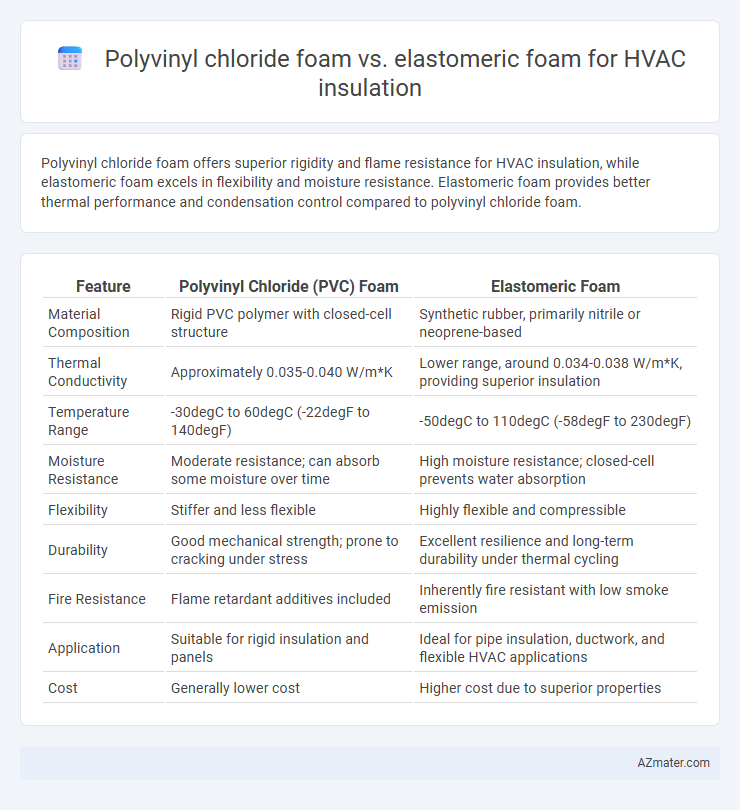Polyvinyl chloride foam offers superior rigidity and flame resistance for HVAC insulation, while elastomeric foam excels in flexibility and moisture resistance. Elastomeric foam provides better thermal performance and condensation control compared to polyvinyl chloride foam.
Table of Comparison
| Feature | Polyvinyl Chloride (PVC) Foam | Elastomeric Foam |
|---|---|---|
| Material Composition | Rigid PVC polymer with closed-cell structure | Synthetic rubber, primarily nitrile or neoprene-based |
| Thermal Conductivity | Approximately 0.035-0.040 W/m*K | Lower range, around 0.034-0.038 W/m*K, providing superior insulation |
| Temperature Range | -30degC to 60degC (-22degF to 140degF) | -50degC to 110degC (-58degF to 230degF) |
| Moisture Resistance | Moderate resistance; can absorb some moisture over time | High moisture resistance; closed-cell prevents water absorption |
| Flexibility | Stiffer and less flexible | Highly flexible and compressible |
| Durability | Good mechanical strength; prone to cracking under stress | Excellent resilience and long-term durability under thermal cycling |
| Fire Resistance | Flame retardant additives included | Inherently fire resistant with low smoke emission |
| Application | Suitable for rigid insulation and panels | Ideal for pipe insulation, ductwork, and flexible HVAC applications |
| Cost | Generally lower cost | Higher cost due to superior properties |
Introduction to HVAC Insulation Materials
Polyvinyl chloride (PVC) foam and elastomeric foam are widely used HVAC insulation materials providing thermal resistance and energy efficiency. PVC foam offers rigid structure with excellent moisture resistance and fire retardancy, making it ideal for duct insulation in harsh environments. Elastomeric foam delivers superior flexibility, sound absorption, and mold resistance, suitable for piping and equipment insulation where vibration dampening is critical.
Overview of Polyvinyl Chloride (PVC) Foam
Polyvinyl Chloride (PVC) foam is a lightweight, closed-cell insulation material widely used in HVAC systems for its excellent thermal resistance and moisture barrier properties. Its inherent chemical stability and fire-retardant characteristics make it suitable for environments requiring safety and durability. Compared to elastomeric foam, PVC foam offers superior compressive strength and resistance to oil and solvents, enhancing long-term performance in HVAC applications.
Overview of Elastomeric Foam
Elastomeric foam is a flexible, closed-cell insulation material commonly used in HVAC systems for its excellent thermal insulation and moisture resistance properties. It provides superior flexibility, preventing cracking or splitting in temperature fluctuations, and offers outstanding resistance to mold, mildew, and chemicals. This foam type effectively reduces energy costs by improving system efficiency and prolonging the lifespan of HVAC components.
Thermal Insulation Performance Comparison
Polyvinyl chloride (PVC) foam exhibits superior thermal insulation performance due to its closed-cell structure, which significantly reduces heat transfer and enhances energy efficiency in HVAC systems. Elastomeric foam, while flexible and resistant to moisture, generally offers lower thermal resistance compared to PVC foam, leading to increased heat loss in certain applications. Selecting PVC foam for HVAC insulation optimizes thermal barrier properties, contributing to better temperature regulation and reduced energy consumption.
Moisture and Vapor Resistance
Polyvinyl chloride (PVC) foam offers superior moisture and vapor resistance compared to elastomeric foam, making it ideal for HVAC insulation in humid environments. PVC foam's closed-cell structure prevents water absorption and vapor penetration, reducing the risk of mold and corrosion in ductwork. Elastomeric foam, while flexible and more resistant to thermal bridging, typically has higher vapor permeability, necessitating additional vapor barriers in moisture-prone applications.
Fire Resistance and Safety Ratings
Polyvinyl chloride (PVC) foam offers superior fire resistance in HVAC insulation due to its inherent self-extinguishing properties and compliance with ASTM E84 Class A flame spread ratings, reducing smoke production and toxic gas emission. Elastomeric foam, while providing excellent thermal insulation and flexibility, typically features a lower fire resistance rating and may require additional fire-retardant treatments to meet UL 94 V-0 or similar safety standards. Selection between PVC and elastomeric foam depends on specific HVAC fire safety requirements, balancing fire resistance performance with thermal insulation efficiency.
Durability and Longevity
Polyvinyl chloride (PVC) foam offers superior durability and resistance to moisture, chemicals, and UV exposure, making it ideal for long-term HVAC insulation applications. Elastomeric foam, while flexible and effective in thermal insulation, tends to degrade faster under harsh environmental conditions, including exposure to oils and ozone. The longevity of PVC foam generally exceeds that of elastomeric foam, providing extended service life and reduced replacement frequency in HVAC systems.
Installation and Flexibility Considerations
Polyvinyl chloride (PVC) foam offers ease of installation due to its lightweight structure and self-extinguishing properties, making it ideal for straightforward HVAC insulation projects. Elastomeric foam excels in flexibility, allowing it to conform to irregular surfaces and accommodate thermal expansion, which reduces the risk of gaps and air leaks. While PVC foam provides durability and moisture resistance, elastomeric foam's superior flexibility enhances installation efficiency in complex HVAC configurations.
Environmental Impact and Sustainability
Polyvinyl chloride (PVC) foam insulation in HVAC systems often poses environmental concerns due to its production process involving chlorine and potential release of harmful dioxins during incineration. Elastomeric foam, typically made from synthetic rubber like neoprene or EPDM, offers better sustainability through lower greenhouse gas emissions in manufacturing and superior recyclability. Both materials provide effective thermal insulation, but elastomeric foam's reduced environmental footprint and longer lifespan make it a more eco-friendly choice for HVAC applications.
Cost Analysis and Value for Money
Polyvinyl chloride (PVC) foam typically offers a lower initial cost compared to elastomeric foam, making it a budget-friendly option for HVAC insulation. Elastomeric foam, while more expensive upfront, delivers superior thermal resistance and durability, often resulting in lower long-term energy costs and maintenance expenses. Evaluating the total cost of ownership, elastomeric foam provides better value for money in applications demanding enhanced insulation performance and longevity.

Infographic: Polyvinyl chloride foam vs Elastomeric foam for HVAC insulation
 azmater.com
azmater.com